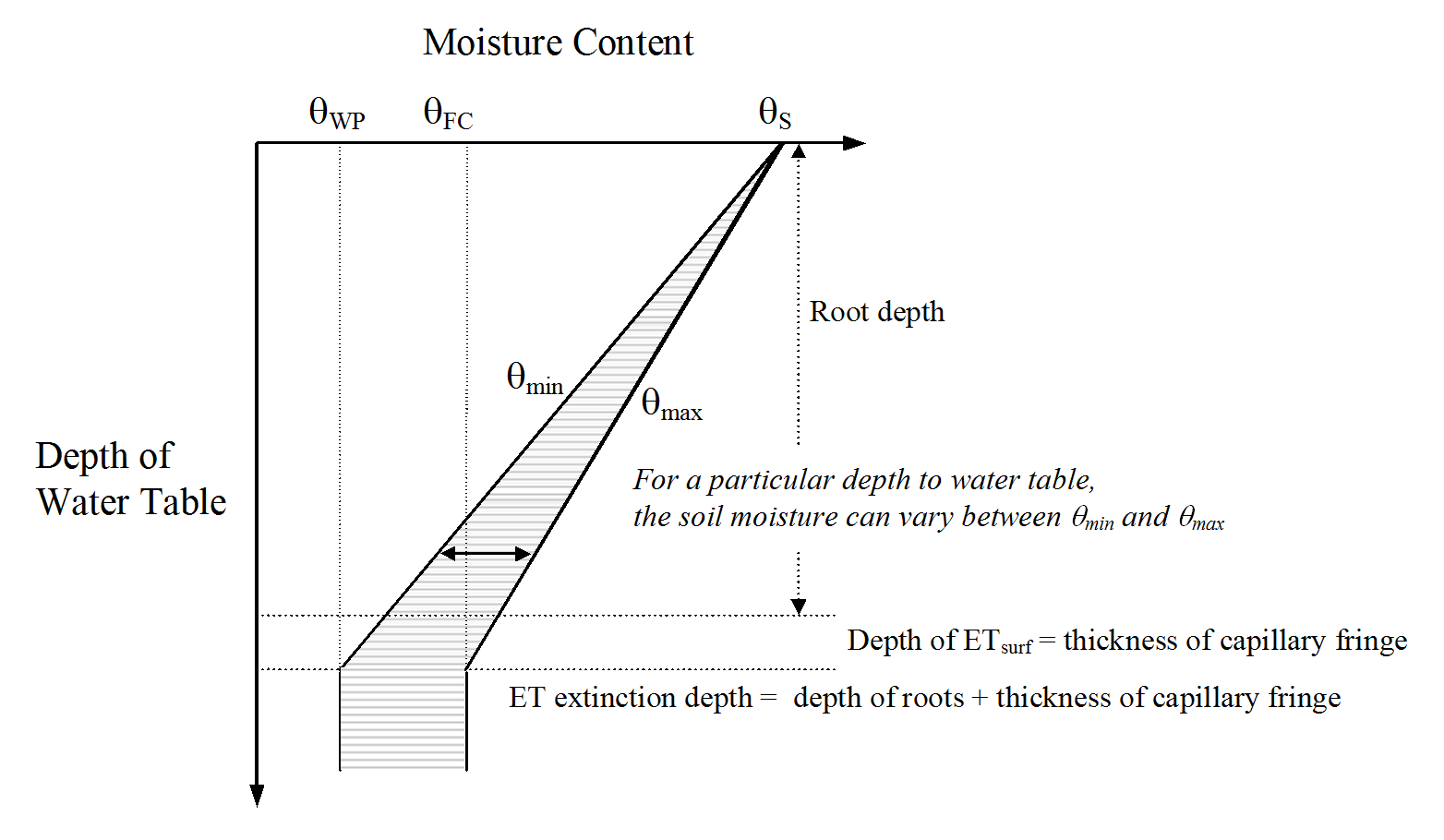
ET Extinction depth - If the capillary fringe reaches the bottom of the root zone, then water removed from the root zone by ET will be replaced by water drawn up by capillary action. The ET extinction depth is then the maximum depth where ET can be removed from the saturated zone by the roots - that is the root depth + the thickness of the capillary fringe.
In the 2-Layer Water Balance Method the unsaturated zone can consist of one or two layers.
· The upper layer extends from the ground surface to the ET extinction depth. If the water table is at the ground surface then the thickness of the upper layer is zero.
· If the water table is below the ET extinction depth, then a second layer is added that extends from the bottom of first layer to the water table. If the water table is above the ET extinction depth, the thickness of the lower layer is zero.

Figure 20.9 Allowable range for soil moisture in the upper ET layer as a function of the depth to the water table.
Water table at ground surface
If the water table is at the ground surface then the moisture content equals the saturated moisture content, qs.
Water table above ET extinction depth
If the water table is above the ET extinction depth, then the average water content in the upper UZ layer will vary between a minimum, qmin, and a maximum, qmax (see Figure 20.9). qmax is the water content that would be present if no ET occurred. qmin is the minimum water content that can exist in the upper ET layer when ET is active. Both qmin and qmax decrease linearly with the depth to the water table. In other words, the average water content of the entire column decreases as the water table drops because the upper part of the column is draining to the field capacity. When the water table is at the extinction depth, the average water content of will be field capacity if there is no ET.
When ET is removed, the water content will decrease from qmax. The water content will increase again up to qmax when infiltration occurs. Thus, the total storage deficit of the top layer of the unsaturated zone, DUZ is
(20.12) 
and the total storage available for ET, SUZ is
where qact is the actual water content at the end of the previous time-step and zwt is the thickness of the upper UZ layer.
Vertical infiltration to the lower UZ layer or to the saturated zone occurs when the water content is equal to qmax.
Water table below ET extinction depth
If the water table is below the ET extinction depth, then a lower UZ layer is added. The moisture content of the lower UZ layer is generally equal to the field capacity because ET is not removed from the lower UZ layer. However, the water content of the lower UZ layer can range between the field capacity and the wilting point. If the water content is equal to field capacity then an infiltration from the upper UZ layer will be added to the top layer of the SZ model as groundwater recharge.
Changing layer thicknesses
The thickness of the upper and lower UZ layers changes whenever the root depth or the water table changes. Thus, even if there is no ET or infiltration, a changing layer thickness will change the average water content of the layer because the current water content will be redisributed within a smaller or larger volume.
If the water content in the upper UZ layer is currently at or near qmin, a decrease in the root depth (e.g. crop harvest) can lead to a redistributed water content that is less than the new qmin. In this case, if the water table is above the extinction depth, water will be transfered from the SZ model to the upper UZ layer to bring the water content back up to qmin. If the water table is below the extinction depth, the water content will simply remain below qmin until infiltration increases the water content, or until the water table rises to the new extinction depth.
If the water table is above the extinction depth and falls, then the restributed water content of the upper UZ layer will be calculated based on the added layer thickness times the saturated water content.
A redistributed water content above qmax in the upper UZ layer will result in discharge to either the lower UZ layer or the upper SZ layer depending on the location of the water table.
The water content of the lower UZ layer is generally at field capacity because ET is not removed from the lower UZ layer. However, changing layer thicknesses will cause a redistribution of water content which can result in a water content below field capacity. For example, if the upper UZ layer water content is at or near qmin and the root depth suddenly decrease (e.g. the root depth could suddenly become zero due to a crop harvest) then the average water content of the lower UZ layer will drop well below field capacity.